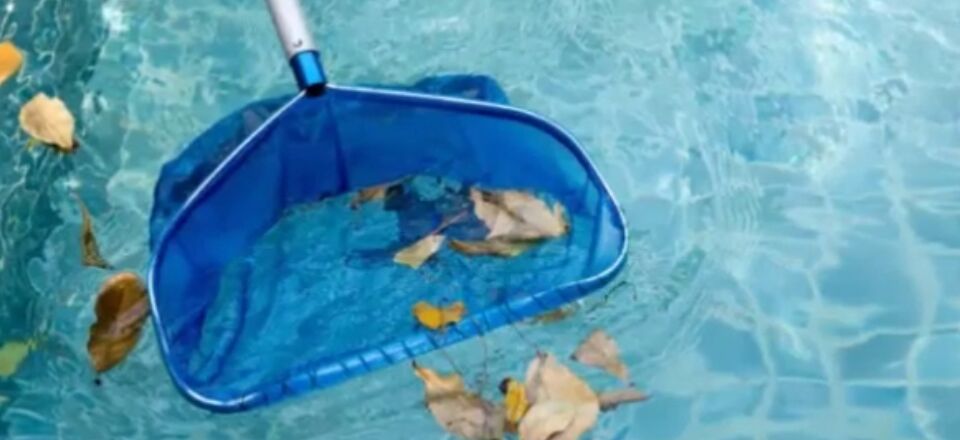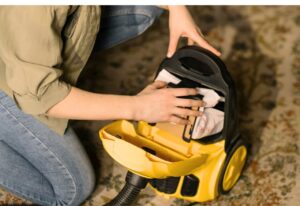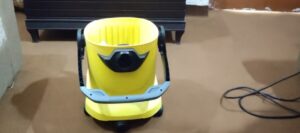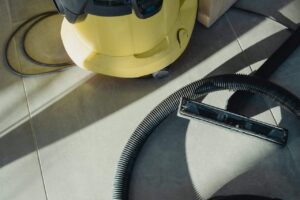When does a pool get dirty? When dry leaves and sand fall into it. As a result, the pool water becomes cloudy. And because of all this, our beautiful backyard area becomes muddy. Therefore, it is very important to keep the area clean to maintain its beauty and attractiveness.
We usually use a vacuum cleaner. But if you don’t have a vacuum cleaner, you can clean the pool yourself with some simple tools and a little effort. So, if you want to know how to get dirt out of a pool without a vacuum, this guide is for you. I have cleaned pools myself many times, and these methods have worked well.
Now we will discuss it in detail, and the process is quite interesting. So, let’s get started.
Table of Contents
Why Dirt Invades Your Pool
It is normal for dirt to get into the pool. Dirt can come in many forms, such as leaves and dust carried by the wind, algae spores from soil or yard debris, human bodies, animals and birds, dirt from the surroundings, and filter problems. A dirty pool is not only unsightly, but it can also cause a variety of problems, such as clogged filters, water imbalances, and the risk of algae growth.
Moreover, a clean pool will save you money. Less dirt means your pump and filter will have to work less, reducing your electricity bills and major repair costs.
So, first of all, knowing where dirt comes from helps you prevent it. Experts say that catching dirt early keeps the pool clean and safe. This guide uses simple, proven methods to clean your pool without a vacuum.
Tools You’ll Need to Clean a Pool Without a Vacuum
You will need some equipment to clean the pool, but don’t worry, you don’t have to buy anything expensive because the equipment is very affordable. Below is a list of some necessary equipment:
- Skimmer net: A long-handled net used to scoop out floating debris like leaves, insects, and other surface dirt from the water.
- Soft-bristle brush: Ideal for scrubbing algae or stains from pool walls and floors. A soft brush is gentler and less likely to scratch the pool surface than a stiff one.
- bucket: Keep a clean bucket nearby for scooping up or pouring water as needed during cleaning.
- Garden hose: Helps create a flow of water that pushes dirt and debris into one spot for easier collection. Especially useful for moving fine silt or dust out of corners.
- Fine-mesh net: This tightly-woven net is excellent for collecting small particles like sand, fine dust, or silt from the water.
- Diatomaceous earth (DE): If your pool filter is compatible, adding DE can help trap ultra-fine debris and improve filtration performance.
- Gloves: Use waterproof gloves to protect your hands from chemicals, grime, and bacteria during the cleaning process.
- Pool test strips: After cleaning, use these to check the water’s pH and chlorine levels to ensure it remains safe and balanced.
- Pool cover: Covering the pool after cleaning helps prevent leaves, dust, and insects from falling in again.
- Shallow tray or dustpan: Useful for scooping up collected dust, sand, or other debris from the bottom of the pool.
- Leaf Rake: If you already have a skimmer net, it’s great for collecting small leaves. But for larger or heavier debris, a leaf rake offers extra convenience.
- Tennis Balls: A fun trick for absorbing sunscreen or body oils from the water, but not part of core cleaning tasks.
- Chemical treatment: These are needed only if the pool has algae problems, unpleasant odors, or high levels of contamination. However, they are not necessary for removing ordinary dirt.
Step-by-Step Methods to Remove Dirt Without a Vacuum
Here are eight methods to clean dirt from your pool, covering everything from leaves to fine silt. Each method is easy and works for different dirt types or pool sizes. Follow these steps to make your pool shine.
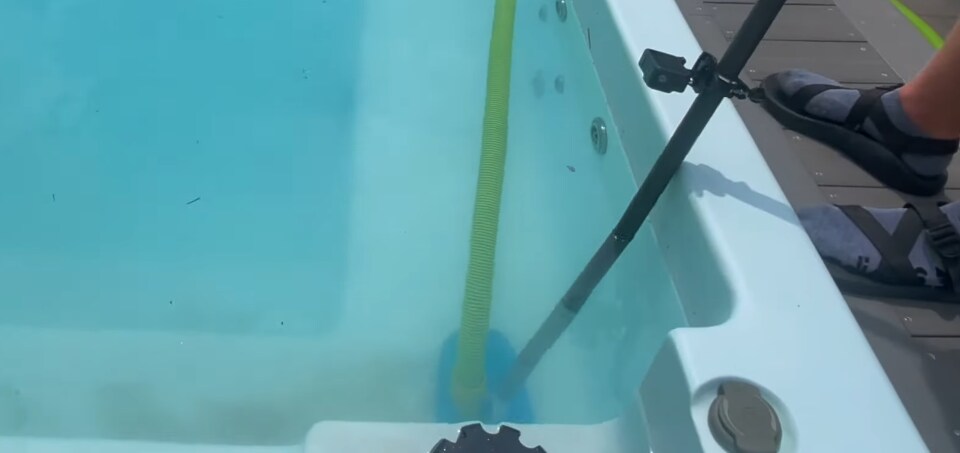
Method 1: Remove Big Debris, Then Scrub It Clean
If your pool looks messy, start with the basics. First, grab a pool skimmer net and glide it gently across the surface to collect leaves, insects, and other floating junk. For heavier stuff sitting on the bottom like twigs or clumps of leaves, use a pool leaf rake attached to a long pole. Move slowly so debris doesn’t scatter, and make sure to cover the entire floor.
Once the big stuff is gone, it’s time to scrub. Use a soft-bristle pool brush to clean the walls, steps, and corners. Scrub in circles and push loosened dirt toward the deep end or main drain. This helps your filter catch whatever the brush kicks up.
If more debris floats up during scrubbing, skim it again. Then, run the pool pump for 2 to 3 hours to help clear out smaller dirt and particles.
Why This Method Works:
Skimming removes the obvious stuff. The rake picks up larger sunken debris. Scrubbing lifts sticky grime, and the pump helps finish the job. It’s a simple way to clean your pool without using a vacuum.
Tips:
- Skim daily to keep things under control.
- Scrub once a week.
- Focus on shady areas where dirt builds up.
- Empty the skimmer basket when it’s full.
- Use gloves if things get slimy.
Method 2: Using Water Flow to Clean Your Pool
Before cleaning, adjust your pool’s jets to direct water toward the filter or main drain. This helps keep dirt suspended, making it easier for the filter to capture debris and keep your pool clean.
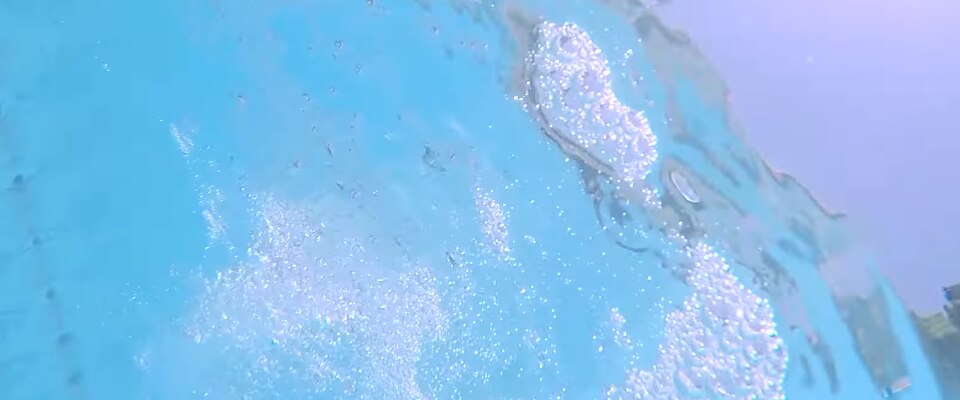
Follow these easy steps:
- Fill a bucket with pool water or use a garden hose set to a soft spray. Avoid strong pressure to prevent stirring up dirt.
- Pour the water slowly at one end of the pool. This steady flow moves dirt along the bottom toward the filter intake or drain.
- Continue pouring for 15 to 25 minutes. If using buckets, make several trips to keep the water flow steady.
- Check the filter’s pressure gauge on the filter tank. If the pressure is high, it means your filter needs cleaning.
- Backwash the filter or clean the cartridge following your pool manual’s instructions. Backwashing rinses dirt out of the filter by reversing the water flow.
- Run the pool pump for 3 to 4 hours to trap and remove loosened dirt from the water.
Why it works: Water flow sweeps dirt to the filter, like herding dust to one spot. I used this after a muddy rain, and my water cleared up fast.
Tips:
- Pour water gently to avoid stirring up dirt clouds.
- Learn how to backwash your filter.
- Use a hose with a soft spray, not a strong blast.
- If using buckets, pour slowly and consistently.
- Clean the filter to keep it working well.
Method 3: Settling and Scooping
If your pool water looks cloudy or full of fine dirt, don’t worry. You can clean it up even without a vacuum. All you need is a little time and a few basic tools.
- Turn off your pool pump at night. This helps the water stay still.
- Let the water sit undisturbed for 8 to 12 hours. Tiny dirt like sand, dust, and silt will settle at the bottom.
- In the morning, use a fine-mesh net or pool scoop to gently remove the settled dirt from the pool floor. Move slowly so you don’t stir the dirt back into the water.
- Optional but helpful: Add a natural clarifier to clump tiny particles for easier scooping.
- Use a flashlight if needed to spot dirt in deep corners or shady spots.
- Turn your pump back on after scooping to filter any leftover debris.
Why it works: When water is still, gravity pulls tiny dirt down to the floor. A fine mesh skimmer or scoop can lift out those particles without using a vacuum. Many pool owners use this method after storms or pool parties, when sand or mud gets in the water
Tips:
- Work slowly while scooping so you don’t stir up more dirt.
- If you don’t have a net, try using a manual siphon or even a clean dustpan to collect settled dirt.
- Avoid swimming during the settling time—movement will stir everything up.
- Don’t overuse clarifiers—they can clog your filter if added too often.
- Wear gloves if dealing with slimy gunk or algae buildup.
Method 4: Supercharging Your Filter with DE Powder:
Sometimes, regular filters can’t catch the tiniest particles in your pool water. That’s where Diatomaceous Earth (DE) comes in. It’s a powder made from natural fossil shells that helps your filter trap super fine dirt like dust, pollen, or algae spores.
- Check if your filter is compatible with DE. Most sand and DE filters work, but cartridge filters usually do not.
- While your pool pump is running, slowly pour 1–2 cups of DE powder into the skimmer. Use less for smaller pools.
- Run the filter for 4-6 hours to trap tiny dirt like dust or pollen.
- Check the pressure gauge. Backwash or clean the filter if the pressure is high.
- Repeat if needed, but don’t add too much DE.
Why it works: DE boosts your filter to catch super small particles. It’s like giving your filter a turbo mode. I used this for cloudy water, and it worked great.
Tips:
- Wear a mask when handling DE. It’s safe, but you don’t want to breathe in the fine dust.
- Use small amounts to avoid clogging.
- Confirm DE works with your filter type.
- Monitor pressure to protect your filter.
- You can buy a big bag of DE from pool supply stores for around $15
- Backwash after DE to keep the filter clean.
- Store DE in a dry place so it doesn’t clump
Method 5: Bucket Scooping for Heavy Debris
- Fill a bucket with pool water to add weight.
- Lower it gently to the pool bottom where sand or pebbles have settled.
- Tilt to scoop debris without stirring it up.
- Lift slowly and dump debris away from the pool.
- Repeat until the bottom is clear.
Why it works: Buckets grab heavy debris that brushes can’t move. This method cleared gravel from my pool after a storm.
Tips:
- Use a 1-2 gallon bucket for control.
- Move slowly to keep the water clear.
- Pair with Method 3 (settling) for best results.
- Wear gloves to stay clean.
- Dispose of debris far from the pool.
Method 6: Surface Skimming with a Tray
- Fill a shallow tray or dustpan with pool water.
- Lower it just below the surface to catch fine debris like pollen or dust.
- Glide slowly to trap particles using surface tension.
- Empty the tray and repeat until the surface is clear.
- Run the pump to filter any remaining bits.
Why it works: Surface tension pulls tiny debris into the tray, catching what the nets miss. I used this for dusty water, and it was surprisingly effective.
Tips:
- Use a clean, wide container for better coverage.
- Move slowly to avoid pushing debris away.
- Clean on a calm, wind-free day.
- Combine with Method 1 for a polished surface.
- Empty the tray frequently.
Method 7: Pool Leaf Trap
- Get a clean, empty plastic bottle (like a 2-liter soda bottle).
- Cut off the top third of the bottle to make a wide opening.
- Lower the bottle upside down into the water to trap floating leaves or bugs.
- Scoop gently and lift to remove debris.
- Empty the bottle and repeat until the surface is clean.
Why it works: The bottle acts like a mini-trap for floating debris. I made one from an old jug, and it grabbed leaves, but skimmer nets missed.
Tips:
- Use a clean bottle to avoid adding dirt.
- Move slowly to trap debris without splashing.
- Combine with skimming for bigger messes.
- Recycle the bottle when done.
- Do this daily for heavy leaf areas.
Method 8: Tennis-Ball Trick for Oily Water
Sunscreen or body oils making your pool look slimy? Tennis balls can fix that in a snap.
Steps:
- Grab 2–3 clean tennis balls.
- Drop them in the pool and let them float for a day
- Their fuzzy surface sucks up oils like a sponge
- Take the balls out, rinse them with clean water, and save them for later
- Run the pool pump for 1–2 hours to clear any leftover bits
Why It Works: The fuzzy coating on tennis balls grabs greasy stuff your filter might miss. I used this after a swim party, and my pool looked amazing.
Tips
- Use clean balls to keep dirt out.
- Rinse them daily if they get gross
- Pair with skimming for a super clean pool
- Store dry for next time
How to Keep Dirt Out of Your Pool
Want to spend less time cleaning your pool? These easy steps will help stop dirt, leaves, and grime from getting into your water, keeping it clear and ready for a swim:
- Cover your pool: Use a cover during storms or when not in use to block debris. My cover slashed my cleaning time.
- Skim daily: A quick 5-minute skim prevents buildup.
- Maintain the filter: Clean or backwash weekly to keep it effective.
- Trim trees: Cut back branches to reduce leaves and pollen.
- Control runoff: Use rocks or plants to block mud during rain.
- Rinse swimmers: Ask everyone to rinse off dirt or sunscreen before jumping in.
- Smart landscaping: Use gravel or pavement near the pool instead of loose dirt.
- Check the weather: Skim extra before storms to stay ahead.
- Add windbreaks: Fences or shrubs reduce windblown debris.
Mistakes to Avoid
Avoid these mistakes, or all your efforts will be in vain:
- Wrong chemicals: Household cleaners like bleach can ruin water balance or damage liners. Stick to pool-safe products.
- Scrubbing Too Hard: Don’t grab your regular household bleach or bathroom cleaner for pool care. These products can mess up your water’s chemical balance or even damage your pool liner. Always use pool-safe chemicals made for swimming pools
- Forgetting the Filter: Your pool filter works hard to keep the water clean, but if it’s clogged or dirty, it can’t do its job. Check and clean your filter every week to make sure it’s working at full power.
- Using regular vacuums: Never use a household vacuum cleaner near your pool, as it isn’t safe around water and could break or cause electric shocks. Use a pool vacuum instead.
- Too Much Clarifier or DE: More isn’t always better. Overusing this product can clog your filter or make the water cloudy. Always follow the product’s instructions.
- Skipping Water Testing: Just because a pool looks clean doesn’t mean the water is healthy. You should test your pool’s pH, chlorine, and other levels regularly. Especially after cleaning to make sure everything is balanced. Otherwise, the water may remain cloudy.
- Cleaning in bad weather: Wind or rain can blow in more dirt while you’re cleaning. Wait for a calm, clear day
- Ignoring small debris: Small stuff like pollen or dust adds up fast. Skim the surface daily to stop buildup
Troubleshooting Tough Dirt
If dirt won’t budge, try these solutions:
- Cloudy water: Test pH (ideal: 7.2-7.6) and chlorine (1-3 ppm) with strips. Adjust with pool-safe chemicals.
- Algae: Green or slimy water means algae. Brush thoroughly and use an eco-friendly algaecide.
- Post-storm mess: Combine Methods 3 (settling) and 5 (bucket scooping). Skim leaves first.
- Filter problems: If water stays dirty, clean or backwash the filter. Replace if it’s old.
- Recurring dirt: Check for runoff or overhanging trees. Use a cover or barriers.
- Fine silt or pollen: Use Method 6 (tray skimming) or Method 4 (DE) for tiny particles.
When to Call a Professional
Most dirt is DIY-friendly, but some cases need expert help:
- Persistent haze: If water stays cloudy despite cleaning, a pro can diagnose it.
- Severe algae: Green, black, or mustard algae may need specialized treatment.
- Equipment issues: Broken filters or pumps require a technician.
- Post-disaster cleanup: Floods or major storms may need professional attention.
Eco-Friendly Cleaning
Clean your pool while keeping the planet in mind:
- Use eco-labeled clarifiers and algaecides.
- Test the water before adding chemicals to avoid waste.
- Reuse pool water for plants if chemical levels are safe (check with strips).
- Stick to reusable tools like nets and brushes.
- Use a solar pool cover to save energy and block dirt.
- Skim daily to reduce chemical use.
Safety
- Wear gloves to protect your skin from dirt or chemicals.
- Follow chemical labels exactly—never mix products.
- Avoid electrical tools near water to prevent shocks.
- Work on non-slip surfaces to avoid falls.
- Keep kids and pets away during cleaning.
- Store chemicals in a cool, dry, secure place.
Final Thought
You don’t always need a vacuum to keep your pool sparkling. Try simple tricks like skimming leaves with a net, scrubbing the walls, and adjusting water flow to help your filter do more. Use a bucket to scoop out larger debris, or even create a DIY bottle trap for fine dirt. These pool cleaning methods are low cost and eco-friendly. To stop mess before it starts, use a pool cover, skim daily, and plant smart landscaping to block extra dirt.
Avoid common mistakes like using harsh pool chemicals or scrubbing too hard. And don’t forget that testing your water helps keep it safe and balanced. I have used all these tricks myself, and they really work. Keeping your pool clean doesn’t have to be expensive or hard; just a little effort goes a long way.
FAQs
Can I clean my pool without tools?
It’s tough, but a bucket can scoop dirt. Nets or brushes make it much easier.
How often should I clean without a vacuum?
Skim daily, scrub weekly, check filters weekly, and scoop as needed.
Are natural clarifiers safe?
Yes, if labeled pool safe. Follow instructions carefully.
Why does dirt keep returning?
Look for runoff, trees, or a lack of cover. Address these to minimize dirt.
Can I use a household vacuum?
No, it’s unsafe and risks damage or shocks. Use pool-specific tools.
What if water stays cloudy?
Test pH and chlorine, adjust with pool safe chemicals, or call a pro.
How do I know if my filter’s working?
Check the pressure gauge. High pressure means clean or backwash it.

Welcome to Homenias, I’m Jaman M, and I’m here to help you discover the best home products. With years of experience, they offer genuine reviews and helpful guides. Their mission is to make your choices easier. It’s organizing your space or finding creative solutions. Explore how the right products can enhance your everyday life. Don’t miss out on finding the best home products to raise your living experience.

